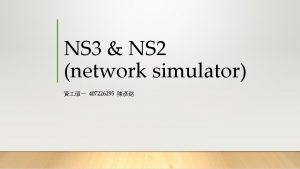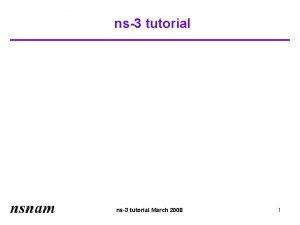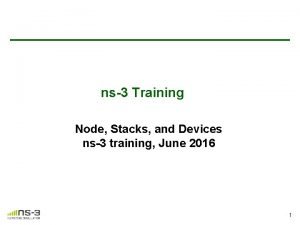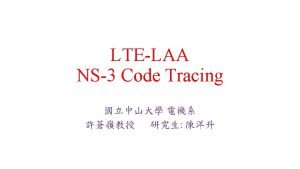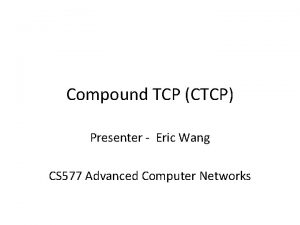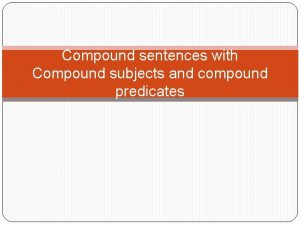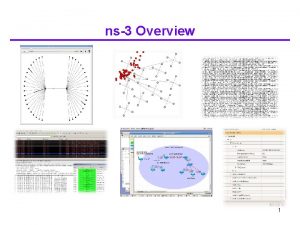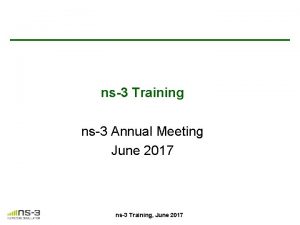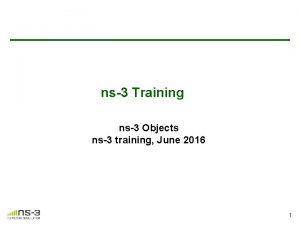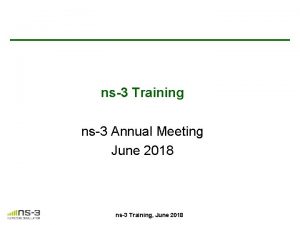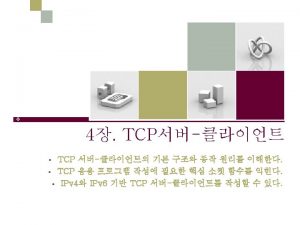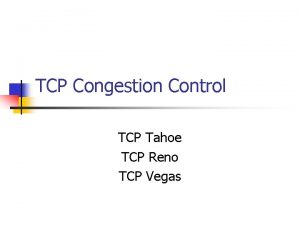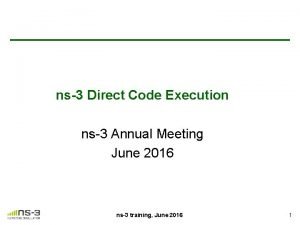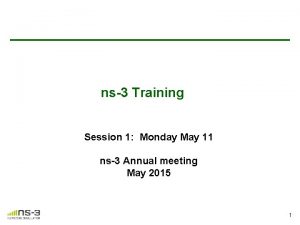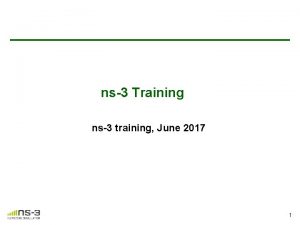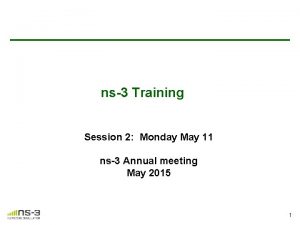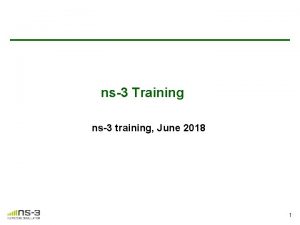Compound TCP in NS3 Keith Craig 1 What





















- Slides: 21

Compound TCP in NS-3 Keith Craig 1

What is Compound TCP? • As internet speeds increased, the long ‘ramp’ time of TCP Reno became an increasingly large issue. • According to an IETF paper in 2003, a 10 Gbps line would require no more than 1 drop every 100 minutes to achieve maximal throughput. • A class of TCP algorithms known as “high speed” TCP algorithms attempt to alleviate this problem. • These algorithms ramp up and recover after loss more quickly in order to more efficiently saturate available bandwidth. 2 Worcester Polytechnic Institute

The Trouble with BIC and Cubic • BIC and Cubic (and loss-only based algorithms in general) exacerbate unfairness in scenarios with competing streams. 3 Worcester Polytechnic Institute

A Hybrid Approach • Compound TCP attempts to mitigate the unfairness issues with BIC and Cubic by introducing a ‘delay based’ component to the congestion window, in the style of TCP Vegas. • Broadly, Compound TCP calculates the total congestion window as the sum of a loss-based window (cwnd) that tracks packet drops, and a delay-based window (dwnd) modified by a moving RTT average. 4 Worcester Polytechnic Institute

Starting Up • At the start of a new connection, CTCP uses the same slow-start behavior that TCP Reno uses. • The dwnd is set to 0, disabling it during slow-start. • For each packet ACKed, the cwnd is incremented by 1. • The algorithm exits slow-start at the first dropped packet. 5 Worcester Polytechnic Institute

Loss-Based Window • CTCP uses the AIMD approach from TCP Reno. • When a packet is successfully ACKed, the cwnd increases by 1/cwnd+dwnd. • When a packet loss is detected, the cwnd is decreased by half. 6 Worcester Polytechnic Institute

Delay-Based Window • A delay-based window attempts to predict oncoming congestion by tracking RTT variations. • CTCP’s algorithm for delay is based on TCP Vegas, the ‘standard’ form of delay-based window TCP algorithms. • Broadly, given knowledge of the ‘best-case’ RTT and the current (or more typically, exponential moving average) RTT, decrease the dwnd if the difference between the two exceeds a defined parameter. 7 Worcester Polytechnic Institute

Delay-Based Numbers • 8 Worcester Polytechnic Institute

Window Behavior Goals • 9 Worcester Polytechnic Institute

Dwnd Fills in the Gaps • 10 Worcester Polytechnic Institute

CTCP Under Delay Conditions • 11 Worcester Polytechnic Institute

CTCP Implementations • CTCP is the default implementation in Windows systems, beginning with Windows Vista and Windows Server 2008. • A Linux implementation was added to the kernel, but no longer compiles in versions 2. 6. 17 or later, due to changes to the TCP stack implementation. • The closed nature of Windows and the current state of the Linux implementations means there may be no open source implementation of CTCP available. 12 Worcester Polytechnic Institute

Windows CTCP • The Windows CTCP implementation, owing to the closed nature of Windows, is itself proprietary. • The original version appearing in Windows Vista, however, was written by the paper authors, and the original version of it was used for testing in the paper. • A few implementation optimizations are suggested in the paper: ─ Sampling only M RTTs per segment, where M is proportional to the RTT itself, since TCP flows only change their sending rate as their RTT ─ Setting ‘k’ to be ¾ instead of 5/6, as it is faster to calculate. 13 Worcester Polytechnic Institute

Linux CTCP • The implementation of CTCP in Linux (2. 6. 16) is similar, but not identical to the original CTCP paper. • Has parameters alpha, beta, gamma, and zeta as in the paper. • α=3, β=1, γ=30, ζ=1 • K (the exponent in cwnd growth) is defined at a fixed 0. 75. 14 Worcester Polytechnic Institute

Linux CTCP • The current RTT value is not set based on a moving average, but rather is the last seen RTT. • Additionally, RTTs are sampled. This is an optimization mentioned in the original CTCP paper to reduce packet handling overhead. • The CTCP paper recommended k = 5/6 (based on emulating the HSTCP response slope). The linux implementation uses 0. 75 as an approximation, allowing the use of Newton-Raphson for quartic roots. 15 Worcester Polytechnic Institute

CTCP In NS-3 • The ns-3 simulator is the latest version of the ns family of network simulators originally created and used in the RED paper. • Many newer algorithms (some of which were implemented in ns-2) are not yet implemented in ns-3. • CTCP is one of the algorithms not yet implemented; Cubic was only recently implemented in ns-3. 16 Worcester Polytechnic Institute

Which Version of CTCP? • Since both the implied implementation of CTCP on Windows and the verifiable implementation of CTCP on Linux are similar in their modifications from ‘paper CTCP’, both should provide similar performance. • The Linux version of CTCP was thus used as the primary implementation reference for CTCP in ns 3. 17 Worcester Polytechnic Institute

Implementation in ns-3 • The underlying Tcp. Socket. Base class in ns-3 provides the core TCP functionality. • Tcp. Socket provides New. Ack() and Dup. Ack() virtual methods to override to modify the cwnd, dwnd and window parameters. • Tcp. Socket also provides the slow-start functionality that CTCP uses. 18 Worcester Polytechnic Institute

Implementation in ns-3 • New. Ack() is called from the lower layers whenever a new acknowledgement is received. • When this happens, we can increment our cwnd value according to additive increase. • We also update the RTT estimates and Increase. Dwnd() or Throttle. Dwnd() as necessary. • Dup. Ack() is called whenever a packet has been dropped. • When this happens, cwnd is halved and dwnd is reduced by the (1 -beta) factor. 19 Worcester Polytechnic Institute

Verification • In order to verify the correctness of the implemented algorithm in ns-3, it should be tested against the behavior of real-world CTCP implementations – Windows and Linux. 20 Worcester Polytechnic Institute

Questions? 21 Worcester Polytechnic Institute
 Ns3 network simulator
Ns3 network simulator Ns3 tutorial
Ns3 tutorial Ns3 training
Ns3 training Internet stack helper ns3
Internet stack helper ns3 Compound tcp
Compound tcp Lte full duplex
Lte full duplex Ns3 training
Ns3 training Ns-3 tutorial
Ns-3 tutorial Compound tcp
Compound tcp Simple sentence with a compound predicate
Simple sentence with a compound predicate Pauline and bruno have a big argument
Pauline and bruno have a big argument A compound differs from an element in that a compound
A compound differs from an element in that a compound Simple subject and compound predicate
Simple subject and compound predicate A compound differs from an element in that a compound
A compound differs from an element in that a compound Simple, compound-complex rules
Simple, compound-complex rules Craig redford
Craig redford Climograph of toronto
Climograph of toronto Craig heller
Craig heller Craig sloan nnsa
Craig sloan nnsa Jitasol
Jitasol Chris gardner
Chris gardner Craig mulcahy
Craig mulcahy
